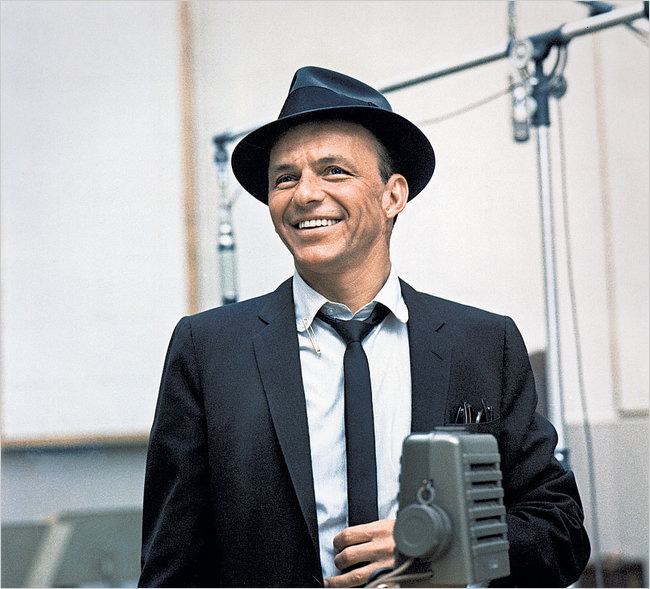The Song Sinatra Bit!
“That’s Life” was the first Frank Sinatra tune that appealed to me. I was a 13-year-old when I first heard it and was not yet a fan of Sinatra’s. His sixties radio hits “Strangers in the Night,” “Love and Marriage,” and “It Was a Very Good Year,” were turn-offs, and no amount of hype could persuade me that he was in the same league as the Temptations, the Stones, the Animals, and other personal favorites of my boyhood. But the song’s blues feeling, bold spirit, and strong beat made me reconsider. A corner sandwich shop in my Worcester neighborhood had it on its jukebox, and it wasn’t long before the Chairman of the Board had me digging deep for coin every time I entered the place.
Sinatra biographer Will Freidwald calls “That’s Life” Sinatra’s “most concerted effort to approximate a blues sound.” He premiered the song on his 1966 TV special, “A Man and His Music,” with an arrangement by his great collaborator, Nelson Riddle.
But for his recorded version, he’d called on the redoubtable team of Ernie Freeman and Jimmy Bowen for an arrangement of what Sinatra assessed as “a good tune that gives you something to think about.” The prominence of Mike Melvoin’s Hammond organ added to the arrangement’s contemporary feel, which his drummer Irv Cottler called “ballad rock.” A year earlier, Freeman and Bowen had produced the hugely successful album, Strangers in the Night, which included the title song and another organ-driven tune that became my second Sinatra favorite, “Summer Wind.” Friedwald notes that while Sinatra had influenced Ray Charles’s decision to add strings and sing ballads, he emulated Ray on “That’s Life” by “shouting the blues over a background of pseudo-Raelettes.” Friedwald says Frank sounded “merely sensually funky” singing Riddle’s arrangement, but the “Freeman-Bowen treatment shows that he has come a long way from The Voice of the ’40s and now gasps, growls, grunts, snarls, and all but spits at the audience.”
Bowen told Friedwald that Sinatra had completed a take of “That’s Life” that everyone in the studio including the singer felt was “the one…We played it back and Frank said, ‘Boy! That’s a hit, isn’t it?’ And I said, ‘Well no, If you want a hit you’re going to have to do it one more time.’ Everybody got real quiet and he gave me the coldest look an artist ever gave me. But he went right out, and instead of singing it hip– he was pissed now– he bit it! That’s when he sang “That’s Life.”
Clark DeLeon, writing in the Philadelphia Inquirer 22 years ago, admitted to being 43 before he “got” Sinatra. It was after he’d settled into an “inconsolable funk” following the Phillies Game 3 defeat in the 1993 World Series when he finally felt the redemptive energy in the tune’s phoenix-like chorus:
“I’ve been a puppet, a pauper, a pirate, a poet, a pawn, and a King,
I’ve been up and down and over and out, and I know one thing,
Each time I find myself, flat on my face,
I pick myself up and get back in the race.”
DeLeon wrote, “It was like Popeye finding spinach…With one song, Frank Sinatra had drop-kicked my self-indulgent gloom out the window…The sound of his voice was a tonic, a wonder drug taken by ear.”
“That’s Life” was perfectly matched to the new swagger that Sinatra began exhibiting in the mid-sixties. He first heard the song through the version O.C. Smith recorded in 1965. Smith sang with Count Basie’s touring band between 1961 and ’65, and he and Sinatra had become friends through their mutual association with the Count. During that period, Sinatra recorded two studio albums with Basie, toured Europe with the band, and played his legendary engagement at the Sands in Las Vegas with Basie in 1966. (Sinatra at the Sands was the first live album released by the singer.)
Here’s Smith singing it before a Los Angeles nightclub audience that recognizes where he’s come from (41st and Hooper) and where he’s now at (Olympic and Hauser) on the strength of the second life he enjoyed with the song. O.C.’s inaugural release of “That’s Life” was a regional hit around L.A. and Detroit in ’66, but after Sinatra’s version climbed the charts the following spring, Smith enjoyed a national hit with his too.
In 1968, the nation was devastated by the assassinations of Martin Luther King, Jr. and Sinatra’s old nemesis Bobby Kennedy. The night after King’s death, April 5, 1968, James Brown was scheduled to play the Boston Garden. In an effort to keep Boston calm and its streets riot-free, Mayor Keven White considered cancelling the concert, but the city’s sole black City Councilor, Tom Atkins, persuaded White to let it proceed and have it broadcast on local television. The concert has long been credited with keeping the peace in Boston. After opening remarks by Atkins and the mayor, JB opened the show (here @ 7:45) with “That’s Life.”
